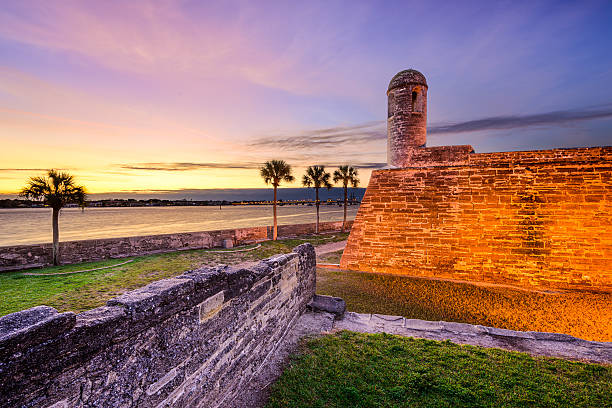17 Feb History Of Castillo de San Marcos
 The Castillo de San Marcos is a historic fort in St. Augustine, Florida that the Spanish built to protect their settlement from pirates, Native American attacks, and other countries trying to take over. It’s a symbol of the conflicts and interactions between different cultures that helped shape the United States. The fort has never been taken over in battle, making it an important piece of history. It’s also the oldest stone fort in the United States, showing the lasting impact of Latino heritage and other cultural groups on the country.
The Castillo de San Marcos is a historic fort in St. Augustine, Florida that the Spanish built to protect their settlement from pirates, Native American attacks, and other countries trying to take over. It’s a symbol of the conflicts and interactions between different cultures that helped shape the United States. The fort has never been taken over in battle, making it an important piece of history. It’s also the oldest stone fort in the United States, showing the lasting impact of Latino heritage and other cultural groups on the country.
The Spanish first came to America in 1513 when Juan Ponce de León found Florida and said it belonged to Spain. They settled in Florida because it was important for protecting their treasure ships. But their early attempts to settle there failed, and in 1561, the king of Spain said they shouldn’t try anymore. However, when they heard the French had settled in Florida, the king changed his mind and sent Pedro Menéndez de Avilés to get rid of them. In 1565, Menéndez and his men built a settlement called San Agustín and attacked and defeated the French at Fort Caroline, making Florida Spanish again.
In the first hundred years of being in St. Augustine, the Spanish faced many attacks that destroyed their wooden forts. They built new wooden forts, but in 1586, an Englishman named Sir Francis Drake attacked and described St. Augustine as a city made of wood. After Drake’s attack and another one by pirate John Davis in 1668, the Spanish asked Spain and Mexico for money to build a stronger defense. They got permission to build a stone fortress, and in 1672, they started building Castillo de San Marcos.
The Spanish built Castillo de San Marcos to withstand cannonballs using a design called the bastion system. It looked like a medieval castle with lowered walls and mounds of earth around it. They also added circular towers at each corner to defend against attacks from land and water. They made drawbridges to get into the castle. The fact that the Castillo is still standing today shows how strong and successful this design was.
Over the years, the castle went through some changes while the Spanish, English, and Americans controlled it. When the Spanish were in charge, Castillo de San Marcos had four big walls made of coquina blocks, a type of limestone. Even though construction was slow because of disease and lack of money, the fort proved its strength during the War of Spanish Succession. In 1702, it was the only building left standing after the English set fire to St. Augustine. To protect the city better, the Spanish extended the castle with more defense lines by 1763.
During the War of Jenkins’ Ear in the 1730s and 1740s, the Spanish governor asked for help to make the walls taller, build an underground powder magazine, and replace part of the fort. But in 1763, when Spain gave Florida to England after the Seven Years’ War, the Spanish left, and the English took over the fort, calling it Fort St. Mark. The British didn’t do much to fix it until the American Revolution when they used it to keep rebel colonists imprisoned.
After the American Revolution, Spain got Florida back, and Castillo de San Marcos became a place where different cultures mixed. However, the Spanish had trouble with Americans from Georgia trying to catch runaway slaves. They made improvements to the fortress, but the Americans still took over Florida in 1821.
Under American control, the fort was used by the War Department and later became Fort Marion. It was damaged and used as a storage place until the Second Seminole War in 1835. By 1842, the Army fixed it up again with new defenses. During the Civil War, it was used as a fort once more.
After the Civil War, with Florida’s development, St. Augustine and the Castillo de San Marcos became popular tourist spots. The government decided to restore the fort, and now it’s managed by the National Park Service. It shows how clever the Spanish were in building it and the different groups of people who lived there. Visitors can explore the fortress, listen to park rangers, watch videos, or see re-enactments.
Amenities at Castillo de San Marcos
- You can take a tour on your own for free when you pay admission.
- Watch cannons fire and see weapon demonstrations for free on Saturdays and Sundays at 10:30 a.m., 11:30 a.m., 1:30 p.m., 2:30 p.m., and 3:30 p.m.
- There are bathrooms available.
- You can buy souvenirs at the gift shop.
- Camping, fishing, riding bikes, and skating are not allowed. You can check Castillo’s website for more information on what you can and can’t do on the grounds.
Best Place to Stay in St. Augustine
St. Augustine, Florida, is famous for its history and nice vibe, making it a great place to visit. One special spot to stay in is Casa de Salona, an old Bed and Breakfast that’s been around for 250 years. It’s right in the middle of the historic district of St. Augustine, so you’ll feel like you’ve gone back in time when you stay there. The building itself is really old, dating back to the 1700s, and it’s been fixed up to look just like it did back then.
The people who run Casa de Salona are friendly and love to share stories about St. Augustine. They’ll tell you all the best places to visit and eat while you’re in town.
One place you should take advantage of is the Castillo de San Marcos, a famous old fortress nearby. It’s a cool spot to learn about the city’s history and see some neat stuff like cannons firing. After a day of exploring, you can come back to Casa de Salona and relax.
If you’re looking for a trip filled with history, charm, and friendly faces, Casa de Salona is the place to stay in St. Augustine. Make your visit to Castillo de San Marcos even better by staying here and experiencing the magic of the city’s past.
GET IN TOUCH
Contact us if you have any questions regarding accommodation or our location in the beautiful heart of Florida’s “Ancient City”: St. Augustine.
21 Aviles Street St. Augustine, FL 32084
Phone: (904) 824-3555
stay@casadesolana.com


